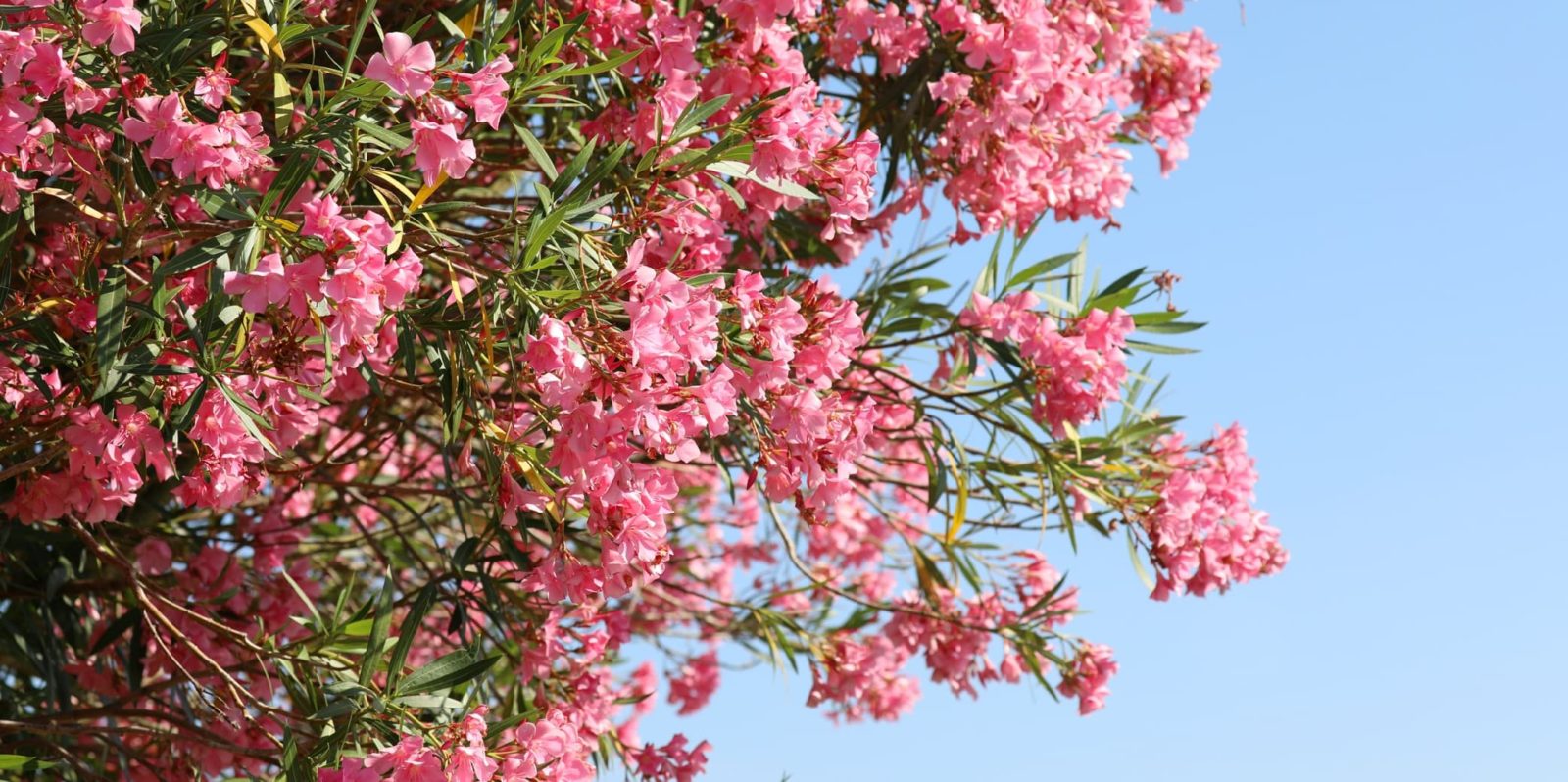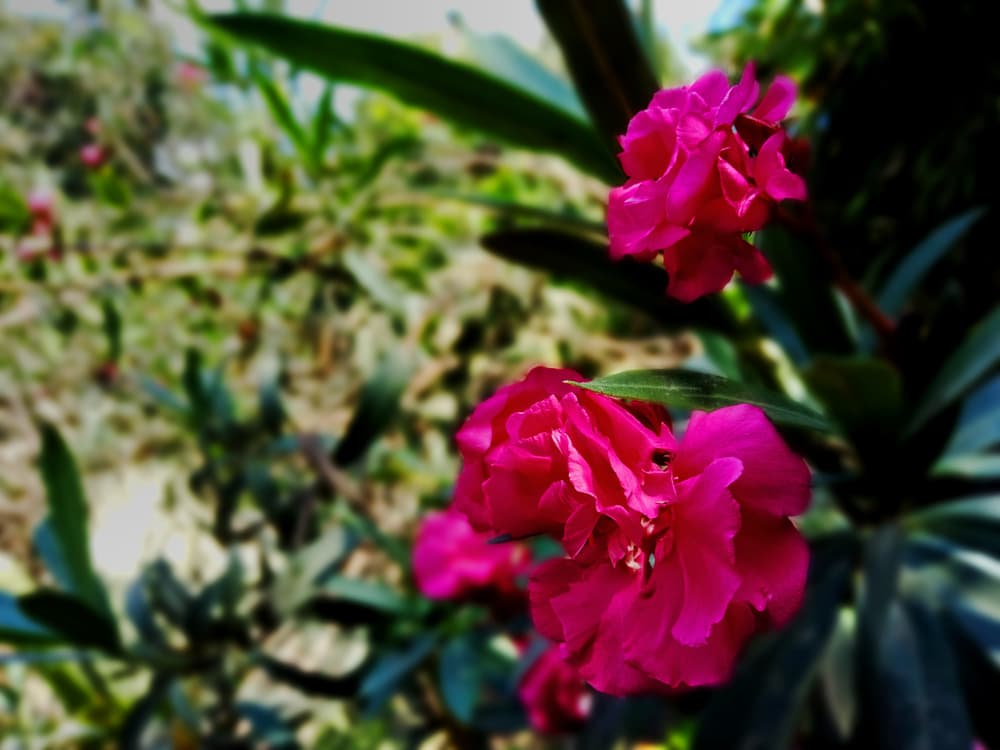Nerium ‘Oleander’ – Only A Handful Of Cultivars Are Hardy Enough For Our Climate

SHRUBS > OLEANDER
Reviewed By COLIN SKELLY

Colin is a Horticulturist and Horticultural Consultant with experience in a range of practical and managerial roles across heritage, commercial and public horticulture. He holds the Royal Horticultural Society’s Master of Horticulture award and has a particular interest in horticultural ecology and naturalistic planting for habitat and climate resilience.
IN THIS GUIDE
OLEANDER GUIDES
Oleander is a storied and reputed plant.
This evergreen bushy plant is low-care, floriferous, and blooms throughout summer.
It produces gorgeous flowers in colours from pure white to blood red.

Tough and tender – that cliched phrase perfectly describes Oleander.
Oleander can tolerate urban jungle heat and is even drought-tolerant to an extent – and it can make do with poor soil and heavy soil, that’s plenty tough.
However, it is very tender – frost tender, that is.
This tough-tender plant doesn’t have to deal with much frost, though, in the regions of the American South where it thrives as an introduced plant.
Overview
| Botanical Name | Nerium oleander |
| Common Name(s) | Oleander, Nerium |
| Plant Type | Shrub |
| Native Area | Mediterranean, North-West Africa, India |
| Hardiness Rating | H2-H5 (depending on variety) |
| Foliage | Evergreen |
| Flowers | Commonly shades of yellow, pink, white or red |
| When To Sow (Indoors) | March, April, May |
| Flowering Months | July, August, September, October |
Sunlight
Preferred
Full Sun
Exposure
Sheltered
Size
Height
1 – 2.5M
Spread
1 – 1.5M
Bloom Time
July – October
Soil
Preferred
Most Fertile Soil Types
Moisture
Moist but well drained
pH
Neutral
Oleander is an evergreen shrub that can be short and ‘shrubby’ or develop a woody stem and grow up to a fair height so that it looks like a small tree.
Dwarf cultivars settle at only 1-2m; the intermediate ones reach heights of 2.5-3.5m.
The cultivars that grow into small trees can attain heights of up to around 7m.
Almost all of them have bushy, open habits and almost all of them are profuse bloomers and flower right from the beginning of summer, sometimes even before, to the end of summer.

Their colours include white, cream, all shades of pink from pale delicate pink to vibrant magenta pink, and deep rich reds.
Oleander belongs to Genus Nerium, which includes a species count of just one!
The sole species is Nerium oleander.1Nerium. (n.d.). Kew Royal Botanic Gardens. Retrieved March 21, 2023, from https://powo.science.kew.org/taxon/urn:lsid:ipni.org:names:30305280-2
The plant’s floral beauty has led it to be cultivated to quite some extent and many cultivars are known to exist.
Habitat & Growing Conditions
Oleander’s habitat and growing conditions are predominantly in mild Mediterranean climates near streams and other waterways, including coastal areas.

Though the large majority of cultivars are hardy to Zone H3, a few are hardy only to Zone H2, while a few more are frost-hardy and suitable for growing in Zones H4 and H5.
“Even in mild coastal areas, even a few degrees of frost are enough to prevent growing many Nerine oleander for a prolonged period,” shares Master Horticulturist Colin Skelly.
“A handful of cultivars are available that are hardier for the UK and should satisfy a yearning for the Mediterranean.”
Having been introduced to the Far East, it now grows wild in several of that region’s countries.
Where To Plant
Most residents of the UK will not be able to plant this frost-tender plant outdoors.
Except for those fortunate enough to be living in balmy (relatively speaking) regions of the UK, most gardeners will perforce need to grow Oleander in a pot, container, or planter so that it can be overwintered indoors.
Oleanders make wonderful patio and deck plants and as long as they get at least several hours of sun they’re great for the balcony too.

A good-sized container or planter with an Oleander can fill any vacant spot in your garden with a gorgeous flowering plant.
If you live in a secluded area by the sea in a mild part of the country and would like to build a windbreak or plant a decorative flowering bush, your jackpot is Oleander in all its cultivars.
How To Grow Oleander
Though Oleander is an evergreen shrub, the hardiness of most cultivars is only to H3 – which means that they cannot be grown outdoors in any but the warmest coastal parts of the United Kingdom, such as a small region in the south-west.
However, you can search for a hardy variety, such as Hardy Pink and Hardy Red, and confidently grow these outdoors in your garden, though in a sheltered location, almost anywhere in the United Kingdom.
Growing From Seed
Oleander can be started indoors from seeds in early spring.
Seeds may be started in a tray or in small pots.

Either way, they should be sown in a sterile potting mix.
- Dampen the potting mix and just lightly dab in the seeds, about three to a pot.
- Seeds need light to germinate so they should not be covered – the lightest of sprinklings of the mix will suffice.
- Oleander seeds germinate after a comparatively long time – 15 to 20 days – so it will help if the conditions are as favourable as possible.
- First, the soil temperature should stay around 20-21°C.
- Next, cover, but do not seal, the pots with cling film or shrink wrap.
- Finally, keep watering the seeds but very lightly so that the potting mix stays just damp.
- As soon as the seeds germinate, remove the cling film and put the pots on a sunny windowsill or where the seedlings can get several hours of direct sunlight.
If you started them in trays, transplant seedlings each to its own pot after they have developed two pairs of true leaves.
If you started them in individual pots, thin as necessary or transplant.
Transplanting
After a year to eighteen months, the plant can be transplanted into its last appropriately-sized container as indicated by the eventual height and spread of the variety.
An Oleander, depending on the ultimate size of the variety, may be grown in a pot, container, or planter.
A halfway decent mixed loam amended with some compost will work very well for Oleander.
It should drain well – overly wet soil or waterlogged soil is a big no-no for Oleander.

In spring, after there is no danger of frost, the plant can be shifted outdoors – it would be wise to harden it for a week to ten days first.
Oleander Plant Care
Watering
In the UK, Oleander should be placed in full sun.
In most regions of the UK a mature Oleander plant’s water needs will be met by rain.
During dry periods you will need to water it, though moderately.

Avoid letting the soil stay dry for more than a few days.
Though Oleander is drought-tolerant, lack of water will affect flowering.
Oleander does not care to be over-watered and should this happen, it will give you a signal: yellowing and yellowed leaves.
Feeding
Although Oleander does well without any fertilising, if you wish you could feed it with a small quantity of a balanced fertiliser in mid-spring, in either liquid or slow-release form.
Otherwise give it a helping of compost.
Growing Varieties
Five varieties are outlined underneath with an eye to including a diversity of heights and spreads, and a matching diversity in floral shapes, forms, and colours.
‘Petite Salmon’

Has an odd name – for an Oleander, the plant is indeed petite at only about 1-1.8m and with the same spread, exhibiting a bushy, dense habit, but there is nothing salmony (or otherwise fishy) about its colour, scent, or anything else.
The salver-shaped flowers are ‘pinwheel petalled’ and are in a delicate tone of baby pink.
‘Twist Of Pink’

Delivers a twist on the foliage too.
The leaves are variegated, displaying irregular but striking yellowish vertical stripes.
This cultivar bears double flowers in a deep, saturated pink, and it is the ruffled pink petals that give the plant its name.
It reaches an ultimate height of just over 2m. It is a very popular variety on the other side of the pond.
‘Splendens’

An intermediate-size cultivar, reaching a height of 3-3.5m with about the same spread.
It has a bushy habit, often vase-shaped.
It bears bowl-shaped double flowers of a particularly neat and symmetrical form.
They are of candy pink hue and have a satiny lustre.
‘Calypso’

A ‘tree-sized’ Oleander as it reaches an ultimate height of 4-5m with a spread almost as wide as its height.
It is heat tolerant, even for an Oleander.
It produces single, very full, salver-shaped flowers of an intense, eye-catching magenta-pink hue.
This variety is especially popular in Florida and Southern California.
‘Hardy Red’

Indeed lives up to its name because it is hardy, at least by Oleander standards, being hardy to Zone H5.
This variety is another large one, attaining a height of up to 4m with a spread of about 3m.
This is one of the most attractive of all Oleanders because of its showy flowers.
They are single, funnel-shaped, and of a riveting blood-red colour.
Common Problems
Oleanders are generally very pest-resistant and disease-free, especially if they are kept outdoors.
If these plants are grown in a greenhouse, they may be subject to attack by glasshouse red spider mite and, less frequently, by scale insects and mealybugs.
Indoor plants are more susceptible to scale insect infestation, and also to red spider mite and aphids to a lesser extent.
You can avoid these problems by keeping indoor plants in rooms that are not heated and that have good air circulation.
References
- 1Nerium. (n.d.). Kew Royal Botanic Gardens. Retrieved March 21, 2023, from https://powo.science.kew.org/taxon/urn:lsid:ipni.org:names:30305280-2

